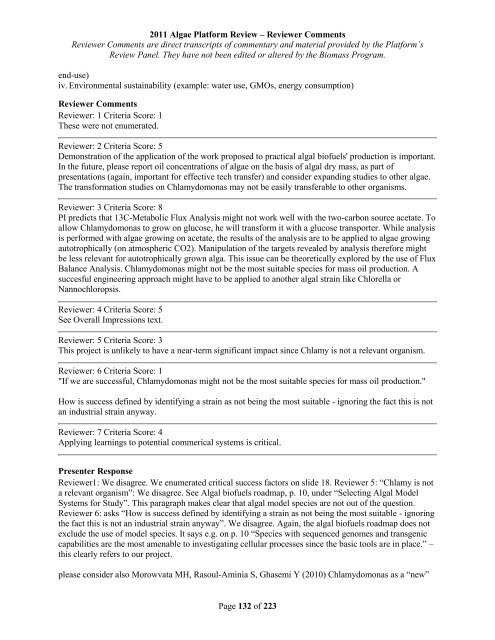Reviewer Comments - EERE
Reviewer Comments - EERE
Reviewer Comments - EERE
You also want an ePaper? Increase the reach of your titles
YUMPU automatically turns print PDFs into web optimized ePapers that Google loves.
2011 Algae Platform Review – <strong>Reviewer</strong> <strong>Comments</strong><br />
<strong>Reviewer</strong> <strong>Comments</strong> are direct transcripts of commentary and material provided by the Platform’s<br />
Review Panel. They have not been edited or altered by the Biomass Program.<br />
end-use)<br />
iv. Environmental sustainability (example: water use, GMOs, energy consumption)<br />
<strong>Reviewer</strong> <strong>Comments</strong><br />
<strong>Reviewer</strong>: 1 Criteria Score: 1<br />
These were not enumerated.<br />
<strong>Reviewer</strong>: 2 Criteria Score: 5<br />
Demonstration of the application of the work proposed to practical algal biofuels' production is important.<br />
In the future, please report oil concentrations of algae on the basis of algal dry mass, as part of<br />
presentations (again, important for effective tech transfer) and consider expanding studies to other algae.<br />
The transformation studies on Chlamydomonas may not be easily transferable to other organisms.<br />
<strong>Reviewer</strong>: 3 Criteria Score: 8<br />
PI predicts that 13C-Metabolic Flux Analysis might not work well with the two-carbon source acetate. To<br />
allow Chlamydomonas to grow on glucose, he will transform it with a glucose transporter. While analysis<br />
is performed with algae growing on acetate, the results of the analysis are to be applied to algae growing<br />
autotrophically (on atmospheric CO2). Manipulation of the targets revealed by analysis therefore might<br />
be less relevant for autotrophically grown alga. This issue can be theoretically explored by the use of Flux<br />
Balance Analysis. Chlamydomonas might not be the most suitable species for mass oil production. A<br />
succesful engineering approach might have to be applied to another algal strain like Chlorella or<br />
Nannochloropsis.<br />
<strong>Reviewer</strong>: 4 Criteria Score: 5<br />
See Overall Impressions text.<br />
<strong>Reviewer</strong>: 5 Criteria Score: 3<br />
This project is unlikely to have a near-term significant impact since Chlamy is not a relevant organism.<br />
<strong>Reviewer</strong>: 6 Criteria Score: 1<br />
"If we are successful, Chlamydomonas might not be the most suitable species for mass oil production."<br />
How is success defined by identifying a strain as not being the most suitable - ignoring the fact this is not<br />
an industrial strain anyway.<br />
<strong>Reviewer</strong>: 7 Criteria Score: 4<br />
Applying learnings to potential commerical systems is critical.<br />
Presenter Response<br />
<strong>Reviewer</strong>1: We disagree. We enumerated critical success factors on slide 18. <strong>Reviewer</strong> 5: “Chlamy is not<br />
a relevant organism”: We disagree. See Algal biofuels roadmap, p. 10, under “Selecting Algal Model<br />
Systems for Study”. This paragraph makes clear that algal model species are not out of the question.<br />
<strong>Reviewer</strong> 6: asks “How is success defined by identifying a strain as not being the most suitable - ignoring<br />
the fact this is not an industrial strain anyway”. We disagree. Again, the algal biofuels roadmap does not<br />
exclude the use of model species. It says e.g. on p. 10 “Species with sequenced genomes and transgenic<br />
capabilities are the most amenable to investigating cellular processes since the basic tools are in place.” –<br />
this clearly refers to our project.<br />
please consider also Morowvata MH, Rasoul-Aminia S, Ghasemi Y (2010) Chlamydomonas as a “new”<br />
Page 132 of 223




